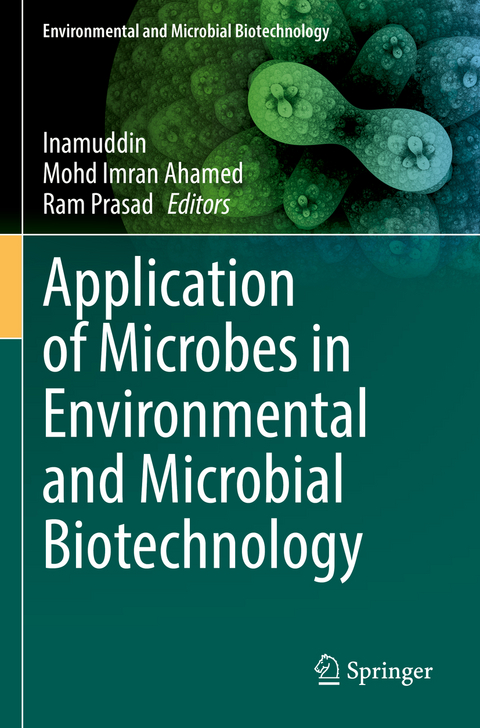
Application of Microbes in Environmental and Microbial Biotechnology
Springer Verlag, Singapore
978-981-16-2227-4 (ISBN)
Dr. Inamuddin, is an assistant professor at the Department of Applied Chemistry, Aligarh Muslim University, Aligarh, India. He has extensive research experience in multidisciplinary fields of analytical chemistry, materials chemistry, electrochemistry, renewable energy and environmental science. He has published about 177 research articles in various international scientific journals, 18 book chapters, and 115 edited books with multiple well-known publishers. His current research interests include ion exchange materials, a sensor for heavy metal ions, biofuel cells, supercapacitors and bending actuators. Dr. Mohd Imran Ahamed received his Ph.D. degree on the topic “Synthesis and characterization of inorganic-organic composite heavy metals selective cation-exchangers and their analytical applications” from Aligarh Muslim University, Aligarh, India, in 2019. He has published several research and review articles in the journals of international recognition. He hasalso edited various books which are published by Springer, CRC Press Taylor & Francis Asia Pacific, and Materials Science Forum LLC, USA. He has completed his B.Sc. (Hons) in chemistry from Aligarh Muslim University, Aligarh, India, and M.Sc. (organic chemistry) from Dr. Bhimrao Ambedkar University, Agra, India. His research works include ion-exchange chromatography, wastewater treatment and analysis, bending actuator, and electrospinning. Dr. Ram Prasad is currently working as an Associate Professor at the Department of Botany, Mahatma Gandhi Central University, Motihari, Bihar, India. Dr. Prasad previously served as an Assistant Professor at Amity University, Uttar Pradesh, India; Visiting Assistant Professor at Whiting School of Engineering, Department of Mechanical Engineering at Johns Hopkins University, USA; and Research Associate Professor at the School of Environmental Science and Engineering, Sun Yat-sen University, Guangzhou, China. Dr. Prasad has more than one hundred fifty publications to his credit, including research papers, review articles & book chapters; has edited or authored several books; and has five patents issued or pending. His research interests include applied microbiology, plant-microbe interactions, sustainable agriculture and nanobiotechnology.
Chapter 1.Impact of isotropic and anisotropic plasmonic metal nanoparticles on healthcare and food-safety management.- Chapter 2. An introduction to different methods of nanoparticles synthesis.- Chapter 3. Classification, Synthesis, and Application of Nanoparticles against Infectious Diseases.- Chapter 4. Nanotechnology in Food Science.- Chapter 5. Facets of Nanotechnology in food processing, packaging and safety: an emerald insight.- Chapter 6. Nanotechnology and its potential application in postharvest technology.- Chapter 7. Nanotechnology mediated detection and control of phytopathogens.- Chapter 8. Nanosystems for Cancer Therapy.- Chapter 9. Phytoplankton mediated nanoparticles for cancer therapy. Chapter 10. Nanotechnology and its potential implications in Ovary Cancer.- Chapter 11. Nanotechnology: An Emerging Field in Protein Aggregation and Cancer Therapeutics.- Chapter 12. Bio-nano interface and its potential application in Alzheimer’s disease.- Chapter 13. Potential of curcumin nanoparticles in tuberculosis management.- Chapter 14. Application of Nanobiosensor in Health care sector.- Chapter 15. Bioactive nanoparticles: A next generation smart nanomaterials for pollution abatement and ecological sustainability.- Chapter 16. Smart nano-materials for bio-imaging applications:An overview.- Chapter 17. Biology of Earthworm in a World of Nano-materials: New Room, Challenges and, Future Perspectives.- Chapter 18. Bioethanol production from agricultural wastes with the aid of nanotechnology.- Chapter 19. Nanotechnology for sustainable bioenergy production.
| Erscheinungsdatum | 10.01.2023 |
|---|---|
| Reihe/Serie | Environmental and Microbial Biotechnology |
| Zusatzinfo | 1 Illustrations, black and white; IX, 736 p. 1 illus. |
| Verlagsort | Singapore |
| Sprache | englisch |
| Maße | 155 x 235 mm |
| Themenwelt | Naturwissenschaften ► Biologie ► Mikrobiologie / Immunologie |
| Technik ► Lebensmitteltechnologie | |
| Technik ► Umwelttechnik / Biotechnologie | |
| ISBN-10 | 981-16-2227-2 / 9811622272 |
| ISBN-13 | 978-981-16-2227-4 / 9789811622274 |
| Zustand | Neuware |
| Haben Sie eine Frage zum Produkt? |
aus dem Bereich


